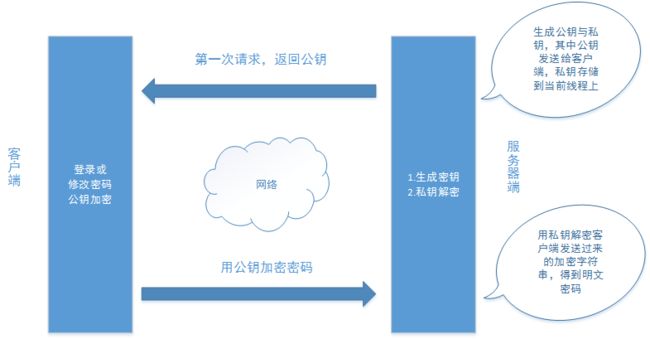RSA加密解密样例
原文地址:RSA加密解密样例
场景:当未启用HTTPS时,用户的登录密码,以及当用户修改密码时,密码在网络中需要加密传输。
一、交互逻辑
上图中,前端部分运行在浏览器上,所以需要用JavaScript来加密需要传输的密码,后端部分使用Java来实现。
二、前端部分
前端部分的加密,选择jsencrypt来实现,代码如下:
//用户修改密码样例
$("#ModifyPasswordBtn").bind("click",function(){
if($("#ModifyPasswordForm").valid()){
//这里的RSA是使用的模块化加载的入口
var encrypt = new RSA.JSEncrypt();
//KEY为公钥
encrypt.setPublicKey(KEY);
var data = {
userUuid:USER.userUuid,
oldPassword:encrypt.encrypt($('#oldPassword').val()),
newPassword:encrypt.encrypt($('#newPassword').val())
};
$.ajax({
url:getServer()+"your action",
type:"post",
data:data,
success:function(data){
var status = data.modifyStatus;
if(status==1){
Util.alert("修改成功");
}else if(status==0){
Util.alert("原密码不正确.");
}else{
Util.alert("修改失败");
}
}
});
}三、后端部分
后端部分使用Java来实现
工具类
package com.share.util;
import java.security.InvalidKeyException;
import java.security.KeyFactory;
import java.security.KeyPair;
import java.security.KeyPairGenerator;
import java.security.NoSuchAlgorithmException;
import java.security.SecureRandom;
import java.security.interfaces.RSAPrivateKey;
import java.security.interfaces.RSAPublicKey;
import java.security.spec.InvalidKeySpecException;
import java.security.spec.PKCS8EncodedKeySpec;
import java.security.spec.X509EncodedKeySpec;
import java.util.HashMap;
import javax.crypto.BadPaddingException;
import javax.crypto.Cipher;
import javax.crypto.IllegalBlockSizeException;
import javax.crypto.NoSuchPaddingException;
public class RSATools {
/**
* 生成RAS公钥与私钥字符串,直接返回
* @return
*/
public static HashMap getKeys(){
HashMap map = new HashMap();
KeyPairGenerator keyPairGen = null;
try {
keyPairGen = KeyPairGenerator.getInstance("RSA");
} catch (NoSuchAlgorithmException e) {
// TODO Auto-generated catch block
e.printStackTrace();
}
// 初始化密钥对生成器,密钥大小为96-1024位
keyPairGen.initialize(1024,new SecureRandom());
// 生成一个密钥对,保存在keyPair中
KeyPair keyPair = keyPairGen.generateKeyPair();
//得到公钥字符串
String publicKey = base64ToStr(keyPair.getPublic().getEncoded());
//得到私钥字符串
String privateKey = base64ToStr(keyPair.getPrivate().getEncoded());
map.put("publicKey", publicKey);
map.put("privateKey", privateKey);
return map;
}
/**
* 从字符串中加载公钥
* @param publicKeyStr 公钥字符串
* @return
* @throws Exception
*/
public static RSAPublicKey loadPublicKey(String publicKeyStr) throws Exception {
try {
byte[] buffer = javax.xml.bind.DatatypeConverter.parseBase64Binary(publicKeyStr);
KeyFactory keyFactory = KeyFactory.getInstance("RSA");
X509EncodedKeySpec keySpec = new X509EncodedKeySpec(buffer);
return (RSAPublicKey) keyFactory.generatePublic(keySpec);
} catch (NoSuchAlgorithmException e) {
throw new Exception("无此算法");
} catch (InvalidKeySpecException e) {
throw new Exception("公钥非法");
} catch (NullPointerException e) {
throw new Exception("公钥数据为空");
}
}
/**
* 从字符串中加载私钥
* @param privateKeyStr 私钥字符串
* @return
* @throws Exception
*/
public static RSAPrivateKey loadPrivateKey(String privateKeyStr) throws Exception {
try {
byte[] buffer = javax.xml.bind.DatatypeConverter.parseBase64Binary(privateKeyStr);
PKCS8EncodedKeySpec keySpec = new PKCS8EncodedKeySpec(buffer);
KeyFactory keyFactory = KeyFactory.getInstance("RSA");
return (RSAPrivateKey) keyFactory.generatePrivate(keySpec);
} catch (NoSuchAlgorithmException e) {
throw new Exception("无此算法");
} catch (InvalidKeySpecException e) {
throw new Exception("私钥非法");
} catch (NullPointerException e) {
throw new Exception("私钥数据为空");
}
}
/**
* 公钥加密过程
* @param publicKey 公钥
* @param plainTextData 明文数据
* @return
* @throws Exception 加密过程中的异常信息
*/
public static String encrypt(RSAPublicKey publicKey, byte[] plainTextData)throws Exception {
if (publicKey == null) {
throw new Exception("加密公钥为空, 请设置");
}
Cipher cipher = null;
try {
// 使用默认RSA
cipher = Cipher.getInstance("RSA");
cipher.init(Cipher.ENCRYPT_MODE, publicKey);
byte[] output = cipher.doFinal(plainTextData);
return base64ToStr(output);
} catch (NoSuchAlgorithmException e) {
throw new Exception("无此加密算法");
} catch (NoSuchPaddingException e) {
e.printStackTrace();
return null;
} catch (InvalidKeyException e) {
throw new Exception("加密公钥非法,请检查");
} catch (IllegalBlockSizeException e) {
throw new Exception("明文长度非法");
} catch (BadPaddingException e) {
throw new Exception("明文数据已损坏");
}
}
/**
* 私钥加密过程
*
* @param privateKey 私钥
* @param plainTextData 明文数据
* @return
* @throws Exception 加密过程中的异常信息
*/
public static String encrypt(RSAPrivateKey privateKey, byte[] plainTextData) throws Exception {
if (privateKey == null) {
throw new Exception("加密私钥为空, 请设置");
}
Cipher cipher = null;
try {
// 使用默认RSA
cipher = Cipher.getInstance("RSA");
cipher.init(Cipher.ENCRYPT_MODE, privateKey);
byte[] output = cipher.doFinal(plainTextData);
return base64ToStr(output);
} catch (NoSuchAlgorithmException e) {
throw new Exception("无此加密算法");
} catch (NoSuchPaddingException e) {
e.printStackTrace();
return null;
} catch (InvalidKeyException e) {
throw new Exception("加密私钥非法,请检查");
} catch (IllegalBlockSizeException e) {
throw new Exception("明文长度非法");
} catch (BadPaddingException e) {
throw new Exception("明文数据已损坏");
}
}
/**
* 私钥解密过程
*
* @param privateKey 私钥
* @param cipherData 密文数据
* @return 明文
* @throws Exception 解密过程中的异常信息
*/
public static String decrypt(RSAPrivateKey privateKey, byte[] cipherData) throws Exception {
if (privateKey == null) {
throw new Exception("解密私钥为空, 请设置");
}
Cipher cipher = null;
try {
// 使用默认RSA
cipher = Cipher.getInstance("RSA");
cipher.init(Cipher.DECRYPT_MODE, privateKey);
byte[] output = cipher.doFinal(cipherData);
return new String(output);
} catch (NoSuchAlgorithmException e) {
throw new Exception("无此解密算法");
} catch (NoSuchPaddingException e) {
e.printStackTrace();
return null;
} catch (InvalidKeyException e) {
throw new Exception("解密私钥非法,请检查");
} catch (IllegalBlockSizeException e) {
throw new Exception("密文长度非法");
} catch (BadPaddingException e) {
throw new Exception("密文数据已损坏");
}
}
/**
* 公钥解密过程
* @param publicKey 公钥
* @param cipherData 密文数据
* @return 明文
* @throws Exception 解密过程中的异常信息
*/
public static String decrypt(RSAPublicKey publicKey, byte[] cipherData) throws Exception {
if (publicKey == null) {
throw new Exception("解密公钥为空, 请设置");
}
Cipher cipher = null;
try {
// 使用默认RSA
cipher = Cipher.getInstance("RSA");
cipher.init(Cipher.DECRYPT_MODE, publicKey);
byte[] output = cipher.doFinal(cipherData);
return new String(output);
} catch (NoSuchAlgorithmException e) {
throw new Exception("无此解密算法");
} catch (NoSuchPaddingException e) {
e.printStackTrace();
return null;
} catch (InvalidKeyException e) {
throw new Exception("解密公钥非法,请检查");
} catch (IllegalBlockSizeException e) {
throw new Exception("密文长度非法");
} catch (BadPaddingException e) {
throw new Exception("密文数据已损坏");
}
}
public static String base64ToStr(byte[] b){
return javax.xml.bind.DatatypeConverter.printBase64Binary(b);
}
public static byte[] strToBase64(String str){
return javax.xml.bind.DatatypeConverter.parseBase64Binary(str);
}
} 生成公钥/私钥
在第一次请求时生成公钥与私钥,并放到当前线程上。返回公钥给客户端。
HashMap map = RSATools.getKeys();
session.setAttribute("PD_CurrentRSAKey", map); 私钥解密
//从session上拿到上次生成的密钥
HashMap map = (HashMap) session.getAttribute("PD_CurrentRSAKey");
RSAPrivateKey privateKey = RSATools.loadPrivateKey(map.get("privateKey"));
//使用私钥解密传输过来的密码
String userUuid = request.getParameter("userUuid");
String oldPassword = RSATools.decrypt(privateKey, RSATools.strToBase64(request.getParameter("oldPassword")));
String newPassword = RSATools.decrypt(privateKey, RSATools.strToBase64(request.getParameter("newPassword"))); 四、可运行的样例
后续提供github地址
My Blog: http://muchstudy.com
